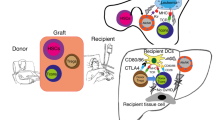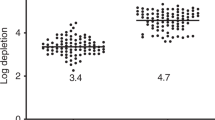Abstract
We have investigated the immune status of patients with hematologic malignancies treated with a low intensity conditioning in preparation for allogeneic stem cell transplantation. Conditioning consisted of fludarabine, anti-T lymphocyte globulin and low-dose busulfan, followed by infusion of allogeneic blood stem cells. This protocol resulted in rapid engraftment and complete replacement of host with donor hematopoietic cells. Immunological parameters of these patients were compared to those patients who were conditioned by an aggressive myeloablative regimen. Distribution of cell surface markers of lymphocyte subsets from both groups of patients was similar, but different from that of normal control cells. Reduced intensity or non-myeloablative conditioning prior to allogeneic stem cell transplantation (NST), hardly lowered the normal T cell-dependent mitogenic response even during the early period following transplant, while the myeloablative treatments resulted in a suppressed mitogenic reaction and in slow immune recovery. Reactivity of non-MHC restricted cytotoxic T cells was also at a normal level in patients who were treated with NST. We conclude that stem cell engraftment following reduced conditioning may result in early reconstitution of immune responses assessed in vitro. We hypothesize that clinical application of NST may lead to faster development of effective immune responses against residual host-type malignant and abnormal non-malignant hematopoietic cells, although the role of fludarabine on post-transplant infections remains to be investigated in a larger cohort of patients. Bone Marrow Transplantation (2001) 28, 243–249.
This is a preview of subscription content, access via your institution
Access options
Subscribe to this journal
Receive 12 print issues and online access
$259.00 per year
only $21.58 per issue
Buy this article
- Purchase on Springer Link
- Instant access to full article PDF
Prices may be subject to local taxes which are calculated during checkout

Similar content being viewed by others
References
Thomas ED . Kettering Award lecture. The role of marrow transplantation in the eradication of malignant disease Cancer 1982 49: 1963–1969
O'Reilly RJ . Allogeneic bone marrow transplantation: current status and future directions Blood 1983 62: 941–964
Horowitz MM, Gale RP, Sondel PM et al. Graft-versus-leukemia reactions after bone marrow transplantation Blood 1990 75: 555–562
Lucarelli G, Galimberti M, Polci P et al. Bone marrow transplantation in patients with thalassemia New Engl J Med 1990 322: 417–421
Symann M, Bosly A, Gisselbrecht C et al. Immune reconstitution after bone marrow transplantation Cancer Treat Rev 1989 16: (Suppl. A) 15–19
Moller J, Hofmann B, Jacobsen N et al. Defective T-cell stimulatory pathways in patients after allogeneic bone marrow transplantation (BMT) in man APMIS 1993 101: 480–486
Kameoka J, Sato T, Torimoto Y et al. Differential CD26-mediated activation of the CD3 and CD2 pathways after CD6-depleted allogeneic bone marrow transplantation Blood 1995 85: 1132–1137
Pignata C, Sanghera JS, Soiffer RJ et al. Defective activation of mitogen-activated protein kinase after allogeneic bone marrow transplantation Blood 1996 88: 2334–2341
Witherspoon RP, Kopecky K, Storb RF et al. Immunological recovery in 48 patients following syngeneic marrow transplantation for hematological malignancy Transplantation 1982 33: 143–149
Witherspoon RP, Lum LG, Storb R . Immunologic reconstitution after human marrow grafting Semin Hematol 1984 21: 2–10
Slavin S, Nagler A, Naparstek E et al. Nonmyeloablative stem cell transplantation and cell therapy as an alternative to conventional bone marrow transplantation with lethal cytoreduction for the treatment of malignant and nonmalignant hematologic diseases Blood 1998 91: 756–763
Keating MJ, Kantarjian H, Talpaz M et al. Fludarabine: a new agent with major activity against chronic lymphocytic leukemia Blood 1989 74: 19–25
Johnson S, Smith AG, Loffler H et al. Multicentre prospective randomized trial of fludarabine versus cyclophosphamide, doxorubicin, and prednisone (CAP) for treatment of advanced-stage chronic lymphocytic leukaemia. The French Cooperative Group on CLL Lancet 1996 347: 1432–1438
Rohatiner A, Lister TA . Management of follicular lymphoma Curr Opin Oncol 1994 6: 473–479
Giralt S, Estey E, Albitar M et al. Engraftment of allogeneic hematopoietic progenitor cells with purine analog-containing chemotherapy: harnessing graft-versus-leukemia without myeloablative therapy Blood 1997 89: 4531–4536
Boyum A . Isolation of leukocytes from human blood Scand J Clin Lab Invest 1968 21: (Suppl. 97) 77–89
Morecki S, Nabet C, Ackerstein A et al. The effect of in vitro T lymphocyte depletion on generation of IL2-activated cytotoxic cells Bone Marrow Transplant 1991 7: 269–273
Petrie A . Linear regression and correlation In: Lecture Notes on Medical Statistics Blackwell: London 1978 pp 102–128
Morecki S, Revel-Vilk S, Nabet C et al. Immunological evaluation of patients with hematological malignancies receiving ambulatory cytokine-mediated immunotherapy with recombinant human interferon-α2a and interleukin-2 Cancer Immunol Immunother 1992 35: 401–411
Shiobara S, Ueda M, Harada M et al. Long-term observation of immunologic reconstitution after allogeneic bone marrow transplantation: differences in recovery among functional T cell subsets Nippon-Ketsueki-Gakkai-Zasshi 1989 52: 55–62
Soiffer RJ, Bosserman L, Murray C et al. Reconstitution of T-cell function after CD6-depleted allogeneic bone marrow transplantation Blood 1990 75: 2076–2084
Parra C, Roldan E, Rodriguez C et al. Immunologic reconstitution of peripheral blood lymphocytes in patients treated by bone marrow transplantation Med Clin Barc 1996 106: 169–173
Bengtsson M, Smedmyr B, Festin R et al. B lymphocyte regeneration in marrow and blood after autologous bone marrow transplantation: increased numbers of B cells carrying activation and progression markers Leukemia Res 1989 13: 791–797
Kelsey SM, Lowdell MW, Newland AC . IgG subclass levels and immune reconstitution after T cell-depleted allogeneic bone marrow transplantation Clin Exp Immunol 1990 80: 409–412
Leino L, Lilius EM, Nikoskelainen J et al. The reappearance of 10 differentiation antigens on peripheral blood lymphocytes after allogeneic bone marrow transplantation Bone Marrow Transplant 1991 8: 339–344
Foot AB, Potter MN, Donaldson C et al. Immune reconstitution after BMT in children Bone Marrow Transplant 1993 11: 7–13
Lowdell MW, Craston R, Ray N et al. The effect of T cell depletion with Campath-1M on immune reconstitution after chemotherapy and allogeneic bone marrow transplant as treatment for leukaemia Bone Marrow Transplant 1998 21: 679–686
Chan EY, Chiu EK, So MK et al. Peripheral blood lymphocyte subsets after allogeneic bone marrow transplantation: reconstitution and correlation with the occurrence of acute graft-versus-host disease Asian Pac J Allergy Immunol 1994 12: 117–123
Lange A, Jazwiec B, Tomaszewska-Toporska B, Toporski J . Recovery of natural cytotoxicity after bone marrow transplantation Immunol Invest 1991 20: 207–213
Comoli P, Maccario R, Montagna D et al. Expression of p75 chain of IL-2 receptor in the early immunological reconstitution after allogeneic bone marrow transplantation Clin Exp Immunol 1994 97: 510–516
Murphy WJ, Longo DL . The potential role of NK cells in the separation of graft-versus-tumor effects from graft-versus-host disease after allogeneic bone marrow transplantation Immunol Rev 1997 157: 167–176
Velardi A, Terenzi A, Cucciaioni S et al. Imbalances within the peripheral blood T-helper (CD4+) and T-suppressor (CD8+) cell populations in the reconstitution phase after human bone marrow transplantation Blood 1988 71: 1196–1200
Lum LG, Joshi ID, Smith MR et al. Constitutive and mitogen-stimulated cytokine mRNA expression by peripheral blood mononuclear cells from most autologous and allogeneic bone marrow transplant recipients is intact Bone Marrow Transplant 1994 13: 187–195
Slavin S, Strober S, Fuks Z, Kaplan HS . Long-term survival of skin allografts in mice treated with fractionated total lymphoid irradiation Science 1976 193: 1252–1254
Slavin S, Strober S, Fuks Z, Kaplan HS . Induction of specific tissue transplantation tolerance using fractionated total lymphoid irradiation in adult mice. Long-term survival of allogeneic bone marrow and skin grafts J Exp Med 1977 146: 34–48
Slavin S, Reitz B, Bieber CP et al. Transplantation tolerance in adult rats using total lymphoid irradiation (TLI): permanent survival of skin, heart and marrow allografts J Exp Med 1978 147: 700–707
Slavin S, Fuks Z, Strober S et al. Overview: transplantation tolerance across major histocompatibility barriers after total lymphoid irradiation Transplantation 1979 28: 359–361
Slavin S . Total lymphoid irradiation (TLI) Immunol Today 1987 8: 88–92
Prigozhina T, Gurevitch O, Zhu J, Slavin S . Permanent and specific transplantation tolerance induced by a non-myeloablative treatment to a wide variety of allogeneic tissues Transplantation 1997 63: 1394–1399
Ildstad ST, Sachs DH . Reconstitution with syngeneic plus allogeneic or xenogeneic bone marow leads to specific acceptance of allografts and xenografts Nature 1984 307: 168–170
Sharabi Y, Sachs DH . Mixed chimerism and permanent specific transplantation tolerance induced by a non-lethal preparative regimen J Exp Med 1989 169: 493–502
Sykes M, Szot GL, Swenson KA, Pearson DA . Induction of high levels of allogeneic hematopoietic reconstitution and donor-specific tolerance without myelosuppressive conditioning Nat Med 1997 3: 783–787
Acknowledgements
This work was carried out in the Danny Cunniff Leukemia Research Laboratory. We wish to thank the Gabrielle Rich Leukemia Research Foundation; Baxter International Corporation; the German–Israel Foundation; the Cancer Treatment Foundation; the Szydlowsky Foundation; and Pauline and Jerry Silverstein for their continuous support of our ongoing basic and clinical research in cell therapy.
Author information
Authors and Affiliations
Rights and permissions
About this article
Cite this article
Morecki, S., Gelfand, Y., Nagler, A. et al. Immune reconstitution following allogeneic stem cell transplantation in recipients conditioned by low intensity vs myeloablative regimen. Bone Marrow Transplant 28, 243–249 (2001). https://doi.org/10.1038/sj.bmt.1703118
Received:
Accepted:
Published:
Issue Date:
DOI: https://doi.org/10.1038/sj.bmt.1703118
Keywords
This article is cited by
-
Assessment of cellular response to mitogens in long-term allogeneic hematopoietic stem cell transplantation survivors
International Journal of Hematology (2021)
-
JC polyomavirus reactivation is common following allogeneic stem cell transplantation and its preemptive detection may prevent lethal complications
Bone Marrow Transplantation (2015)
-
Umbilical cord blood graft engineering: challenges and opportunities
Bone Marrow Transplantation (2015)
-
Impact of lymphocyte and monocyte recovery on the outcomes of allogeneic hematopoietic SCT with fludarabine and melphalan conditioning
Bone Marrow Transplantation (2013)
-
Serological response to influenza vaccine after hematopoetic stem cell transplantation
Annals of Hematology (2010)



